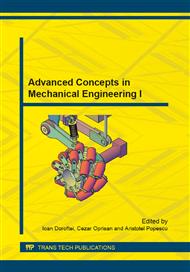p.105
p.111
p.117
p.123
p.129
p.135
p.141
p.147
p.153
ZPA Worms – Definition and Technology
Abstract:
The article presents the definition of a new worm type called ZPA (Pseudo-Archimedes’ Worm), generated with standard cylindrical milling tools on NC lathe. First are showed the enveloping calculus for determining the contact line between the tool and the flank of the worm – considering cylindrical generating surfaces. Knowing the contact line, the axial profile can be determined and implicit the flank of worm. Applying some controlled corrections, this worm type can become a standard worm (ZA – for example). This process is assisted by CAD software, developed by the author. The second part approach ZPA worm’s technology: characteristics of the needed NC lathe, processing steps, tools, cutting conditions. The advantages of the ZPA worm type are: the use of standard tools with reduced costs and also short processing time; the possibilities to cover other standard worms, using the standard cylindrical milling tools and non-specialized NC machining tools.
Info:
Periodical:
Pages:
129-134
Citation:
Online since:
October 2014
Authors:
Keywords:
Price:
Сopyright:
© 2014 Trans Tech Publications Ltd. All Rights Reserved
Share:
Citation:


